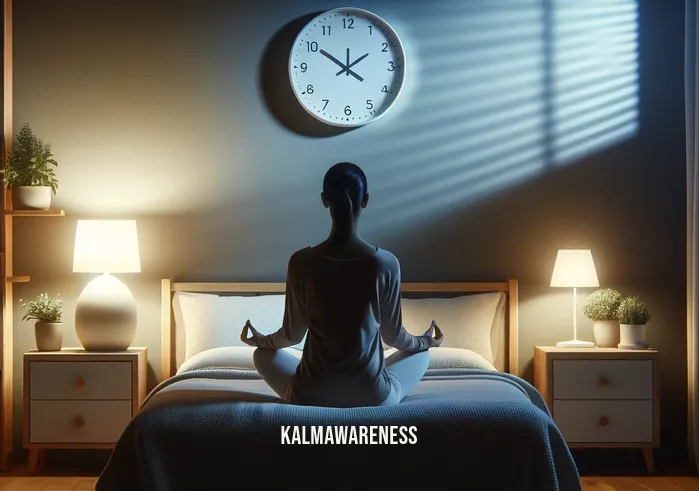Get Back to Sleep Meditation: Unlocking the Secrets of Restful Slumber
Understanding the Importance of Quality Sleep
In our fast-paced world, the quest for a good night’s sleep can often feel like an elusive dream. Yet, the importance of restful slumber cannot be overstated. Sleep is not just a mere pause in our busy schedules; it’s a vital component of our overall health and well-being. For those who find themselves wide awake in the middle of the night, get back to sleep meditation offers a promising solution. This practice isn’t just about closing your eyes and hoping for the best; it’s a systematic approach to calming the mind and body, setting the stage for a restorative sleep experience.
The Role of Meditation in Enhancing Sleep Quality
Meditation has long been recognized for its ability to reduce stress and promote relaxation. When it comes to sleep, meditation can be a game-changer. It helps in slowing down the racing thoughts that often keep us awake and teaches our body and mind to enter a state of deep relaxation, which is conducive to falling asleep. Techniques like mindful movement sleep incorporate gentle movements that can be particularly effective for those who find traditional meditation challenging.
The Power of Mindfulness and EMDR
Mindfulness, a key element in many meditation practices, involves being fully present and aware of our thoughts and feelings without judgment. This can be especially helpful in managing the anxiety and stress that often interfere with sleep. Similarly, EMDR meditation is a technique that can help in processing and releasing emotional distress, leading to a calmer state of mind at bedtime.
Can You Meditate While High?
A question that often arises is whether altered states, such as being high, can affect meditation practices. While meditating while high may offer a different experience, it’s important to approach this with caution and understand how it impacts your individual state of consciousness and relaxation.
Short Meditation Techniques for Quick Relaxation
Not everyone has the luxury of time for long meditation sessions. Fortunately, techniques such as the 15-minute power nap and a brief meditation on breath offer quick ways to relax and reset the mind, making them perfect for those nights when sleep seems just out of reach.
Incorporating Movement and Awareness
For those who prefer a more active approach, practices like floating meditation and relax and be aware combine gentle physical activity with meditative awareness. These can be especially beneficial for individuals who find stillness challenging.
Overcoming Mental Barriers to Sleep
Often, the barriers to sleep are more mental than physical. Techniques like clearing energy meditation and focusing on soles of the feet meditation help in redirecting attention away from the whirlwind of thoughts and towards a more grounded, peaceful state.
Addressing Specific Needs
Different individuals may require different approaches. For example, the mindfulness prescription for adult ADHD offers tailored techniques for those with ADHD, while anxiety attack meditation is designed for moments of acute anxiety.
The Science Behind Meditation and Sleep
The benefits of meditation for sleep are not just anecdotal; they are backed by science. Studies have shown that meditation can significantly improve sleep quality by enhancing the relaxation response of the body. This is further supported by practices like binaural beats for migraine and exploring the 256 Hz benefits in meditation, which use sound frequencies to induce states of deep relaxation.
Embracing a Holistic Approach to Sleep
Get back to sleep meditation is not a standalone solution but part of a holistic approach to better sleep. It’s about creating a conducive environment for sleep, both externally and internally. This involves not just meditation but also considering factors like diet, exercise, and overall lifestyle.
Conclusion: Laying the Foundation for Restful Nights
In this introductory segment, we have explored the basics of get back to sleep meditation and its role in improving sleep quality. From understanding the importance of meditation in this context to exploring various techniques suited for different needs, we have laid the groundwork for a deeper dive into this topic.
In the next chapter, we will delve into specific meditation techniques and how they can be integrated into your nightly routine to combat insomnia and achieve restful sleep. Stay tuned to discover more about transforming your sleep experience and embracing the rejuvenating power of meditation.

Enhancing Restful Sleep with Advanced Meditation Techniques
The Evolution of Sleep Meditation Practices
As we journey further into the world of get back to sleep meditation, it becomes evident that this practice is much more than a mere bedtime routine. It’s an evolution of various techniques and approaches, each designed to address different aspects of sleeplessness. In this chapter, we will explore advanced methods that build upon basic meditation practices, offering a more in-depth approach to overcoming insomnia and enhancing sleep quality.
Advanced Techniques for Deeper Sleep
- Mind Breaths Technique: A method focusing on deep, rhythmic breathing that promotes relaxation and eases the mind into a sleep-ready state. This technique is particularly useful for those who struggle with racing thoughts at bedtime.
- Hand Yoga Poses: Integrating simple hand yoga, or mudras, into your meditation can have a calming effect on the mind and body, aiding in the transition to sleep.
- Kid Calm: Techniques specifically designed for children, helping them to calm their minds and embrace restful sleep more easily.
- Attaining a Peaceful State of Mind: This involves practices aimed at achieving a state where thoughts are not occupied by worry, crucial for uninterrupted sleep.
- Meditation While Lying Down: For those who prefer to meditate in bed, this approach combines the comfort of lying down with the effectiveness of meditation in promoting sleep.
A Comparative Look at Meditation Techniques
| Technique | Primary Focus | Ideal For |
|---|---|---|
| Mind Breaths | Rhythmic Breathing | Calming Racing Thoughts |
| Hand Yoga Poses | Physical and Mental Relaxation | Those Seeking a Physical Element |
| Kid Calm | Child-Friendly Meditation | Children with Sleep Issues |
| Peaceful State of Mind | Reducing Worry and Anxiety | Overthinkers |
| Lying Down Meditation | Comfort and Relaxation | People who Prefer to Meditate in Bed |
The Impact of Meditation on Sleep Cycles
Get back to sleep meditation not only helps in falling asleep but also plays a significant role in enhancing the quality of different sleep cycles. By reducing stress and calming the mind, meditation can increase the duration of deep sleep, essential for physical restoration, and REM sleep, vital for mental health and memory processing.
Integrating Meditation into Your Nightly Routine
To fully reap the benefits of sleep meditation, consistency is key. Integrating these practices into your nightly routine can lead to long-term improvements in sleep quality. Whether it’s incorporating a few minutes of hand yoga poses before bed or practicing mind breaths as you lay down, these small changes can make a significant difference.
Overcoming Specific Sleep Challenges
Each individual faces unique challenges in their quest for restful sleep. For instance, children may benefit from Kid Calm techniques, while adults struggling with anxiety may find solace in practices aimed at attaining a peaceful state of mind. It’s about finding the right technique that resonates with your specific needs.
Conclusion: Preparing for a Deeper Dive into Sleep Meditation
In this chapter, we’ve explored a range of advanced meditation techniques, from rhythmic breathing to kid-friendly practices, each designed to enhance the quality of sleep. As we prepare to delve even deeper into the world of sleep meditation in the next chapter, we will focus on specific case studies and real-life applications of these techniques. Stay tuned to discover how you can tailor these practices to your individual needs and transform your sleep experience. Continue reading to unlock the full potential of meditation in achieving deep, restful sleep.

Discovering Hope Through Sleep Meditation Journeys
The Transformative Power of Meditation for Sleep
In our quest to conquer the challenges of sleeplessness, the journey of get back to sleep meditation serves not just as a remedy but as a source of inspiration and hope. This chapter delves into real-life stories and powerful quotes that underscore the profound impact of meditation on achieving restful sleep. By exploring these narratives, we aim to provide not only insight but also motivation for those seeking solace in the quiet of the night.
Inspirational Quotes to Guide Your Meditation Journey
- “Sleep is not just a function of the body, but a peaceful journey of the mind.” – This quote reminds us that sleep is a holistic experience, encompassing both physical relaxation and mental tranquility.
- “In the stillness of meditation, we find the pathway to peaceful slumber.” – A testament to the power of meditation in paving the way for restful sleep.
- “Each breath in meditation is a step closer to a night of undisturbed dreams.” – Highlighting the role of breathwork in sleep meditation practices.
- “The calm mind is the greatest ally in the quest for restful sleep.” – Emphasizing the importance of mental peace in achieving deep sleep.
Real-Life Stories of Transformation
Overcoming Insomnia with Meditation
John, a 45-year-old accountant, struggled with insomnia for years. His journey with get back to sleep meditation began as a last resort, but it transformed his nights. Through practices like EMDR meditation and mindful movement sleep, John found not just sleep but a new sense of calm that permeated his daily life.
A Mother’s Tale: Finding Rest with Her Child
Sarah, a single mother, faced the dual challenge of managing her own sleep issues while helping her young son, Alex, settle at night. By incorporating child-friendly techniques from Kid Calm, Sarah not only improved her own sleep quality but also helped Alex develop healthy sleep habits.
The Journey Towards Peaceful Nights
Get back to sleep meditation is more than just a technique; it’s a journey towards finding peace and balance in life. These stories of transformation highlight the profound impact that meditation can have on our sleep and overall well-being.
Conclusion: Anticipating Further Discoveries
As we conclude this chapter, filled with hope and inspiration from the powerful narratives of those who have found solace in sleep meditation, we look forward to exploring the next phase of our journey. In the upcoming chapter, we will delve into the scientific underpinnings of meditation and sleep, uncovering how this ancient practice intersects with modern science to enhance our night’s rest. Continue reading to unravel the mysteries of how meditation biologically influences our sleep patterns and overall health.
@
Unraveling the Layers of Sleep Meditation Practices
Delving into the Mechanics of Meditation for Better Sleep
As we journey deeper into the world of get back to sleep meditation, it becomes crucial to break down the various components that make this practice so effective. This chapter focuses on dissecting these elements, using bullet points and lists to clearly present the concepts, ensuring that every aspect of sleep meditation is understood in its entirety.
Key Components of Effective Sleep Meditation
- Mindfulness and Awareness: Central to all meditation practices, these involve being present in the moment and aware of one’s thoughts without judgment.
- Breath Control: Techniques focusing on breath regulation to induce relaxation.
- Body Scanning: Gradually focusing on different parts of the body to release tension.
- Visualization: Imagining calming scenes or experiences to soothe the mind.
- Mantras and Affirmations: Repeating positive phrases to foster a peaceful state of mind.
Techniques Tailored for Specific Needs
- For Racing Thoughts: Techniques like floating meditation help calm an overactive mind.
- For Anxiety: Approaches like clearing energy meditation are effective in managing anxious thoughts.
- For Physical Discomfort: Practices such as mindful movement sleep can alleviate physical tension hindering sleep.
- For Children: Child-specific methods, like those found in Kid Calm, assist in developing healthy sleep patterns early on.
Steps to Incorporate Meditation into Your Nightly Routine
- Set a Regular Schedule: Consistency is key for lasting impact.
- Create a Conducive Environment: Ensure your meditation space is calming and free from distractions.
- Begin with Short Sessions: Start with brief periods and gradually increase the duration.
- Combine Techniques: Use a mix of different methods for a holistic approach.
- Be Patient and Persistent: Recognize that mastery takes time and regular practice.
Overcoming Common Challenges in Sleep Meditation
- Distractions: Strategies to manage external noise and internal chatter.
- Lack of Time: Efficient methods for those with busy schedules, like 15-minute power naps.
- Physical Discomfort: Adjusting postures for optimal comfort and effectiveness.
- Mental Resistance: Techniques to ease into meditation for beginners or skeptics.
Conclusion: Preparing for the Culminating Insights
As we wrap up this chapter, having broken down the intricacies of get back to sleep meditation, we pave the way for a comprehensive understanding of this transformative practice. In the final chapter, we will converge all the insights gained so far, offering a culminating overview that ties together the entire journey. Stay tuned to discover how to integrate these practices into your life seamlessly, leading to nights filled with peaceful, rejuvenating sleep. Continue reading for the concluding insights that will empower you to embrace the full potential of meditation for sleep.
@
Embracing Restful Nights: The Sleep Meditation Journey
Reflecting on the Journey of Sleep Meditation
As we draw our exploration of get back to sleep meditation to a close, it’s time to reflect on the journey we’ve embarked upon together. We’ve delved into the intricacies of various meditation techniques, uncovered real-life stories of transformation, and dissected the mechanics of how these practices aid in achieving restful sleep. Now, let’s look back at the key insights gained and consider how to apply this newfound knowledge to our nightly routines.
Summarizing Our Sleep Meditation Insights
- The Power of Mindfulness: We’ve learned that mindfulness and awareness are at the core of effective sleep meditation, helping to quiet the mind and prepare the body for rest.
- Techniques for Every Need: From floating meditation for racing thoughts to clearing energy meditation for anxiety, we’ve explored a range of techniques tailored to individual needs.
- Integrating into Daily Life: Consistency and a conducive environment are key for successful meditation practice. We’ve seen how even short sessions can make a significant difference.
- Overcoming Challenges: Addressing common obstacles like distractions and mental resistance has been a crucial part of our journey, ensuring a smoother meditation experience.
Applying Our Learning in Real Life
Now that we’ve gathered this wealth of information, the next step is to integrate these practices into our lives. Whether it’s setting aside a few minutes before bed for mindful movement sleep or practicing breath control during moments of stress, each small step can lead to significant improvements in sleep quality and overall well-being.
A Call to Continued Exploration
Our journey may be concluding, but the exploration of sleep meditation doesn’t have to end here. I encourage you to revisit the previous chapters for a refresher or to delve deeper into specific techniques. Remember, each night is an opportunity to practice and perfect your meditation routine.
Gratitude and Looking Ahead
Thank you for joining me on this enlightening journey through the world of get back to sleep meditation. Your time and engagement have been invaluable. As we part ways on this topic, rest assured that more insightful content awaits in future editions. Keep exploring, keep practicing, and most importantly, keep believing in the power of meditation to transform your nights into peaceful havens of rest.
Conclusion: A Future of Restful Slumber
As we conclude, let’s carry forward the hope and serenity we’ve discovered through sleep meditation. May your nights be filled with restful sleep and your days with the energy and clarity that come from it. Remember, the journey to better sleep is not just about closing your eyes; it’s about opening your mind to the possibilities that rest within the realm of meditation.



